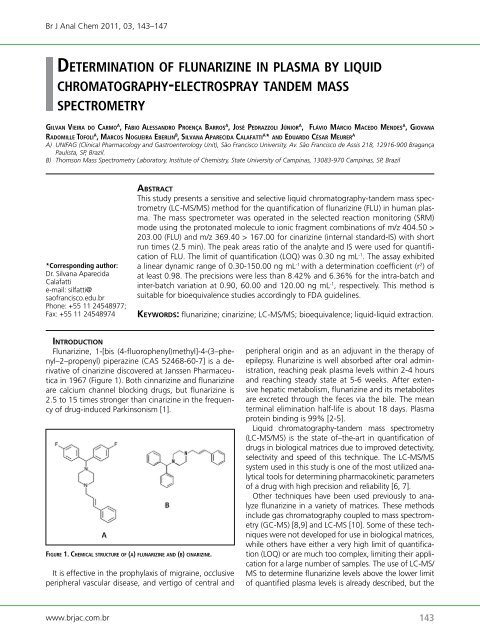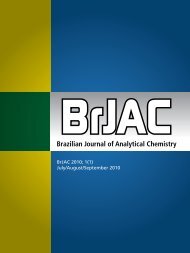Brazilian Journal of Analytical Chemistry - BRJAC - Brazilian Journal ...
Brazilian Journal of Analytical Chemistry - BRJAC - Brazilian Journal ...
Brazilian Journal of Analytical Chemistry - BRJAC - Brazilian Journal ...
Create successful ePaper yourself
Turn your PDF publications into a flip-book with our unique Google optimized e-Paper software.
Br J Anal Chem 2011, 03, 143–147<br />
dE t E r m i n a t i o n o f f l u n a r i z i nE in P l a s m a By liquid<br />
ChromatograPhy-ElECtrosPray t a n d E m m a s s<br />
sPECtromEtry<br />
gi l v a n viEira d o Ca r m o a , fá B i o alEssandro Pr o E n ç a Ba r ro s a , Jo s é PEdrazzoli Jú n i o r a , fl á v i o má rC i o ma C E d o mEndEs a , gi o v a n a<br />
radomillE to f o l i a , ma r C o s no g u E i r a EBErlin B , si l v a n a aP a rE C i d a Ca l a f a t t i a * a n d Ed u a rd o César mEurEr a<br />
A) UNIFAG (Clinical Pharmacology and Gastroenterology Unit), São Francisco University, Av. São Francisco de Assis 218, 12916-900 Bragança<br />
Paulista, SP, Brazil.<br />
B) Thomson Mass Spectrometry Laboratory, Institute <strong>of</strong> <strong>Chemistry</strong>, State University <strong>of</strong> Campinas, 13083-970 Campinas, SP, Brazil<br />
*Corresponding author:<br />
Dr. Silvana Aparecida<br />
Calafatti<br />
e-mail: silfatti@<br />
sa<strong>of</strong>rancisco.edu.br<br />
Phone: +55 11 24548977;<br />
Fax: +55 11 24548974<br />
www.brjac.com.br<br />
ab s t r a c t<br />
This study presents a sensitive and selective liquid chromatography-tandem mass spectrometry<br />
(LC-MS/MS) method for the quantification <strong>of</strong> flunarizine (FLU) in human plasma.<br />
The mass spectrometer was operated in the selected reaction monitoring (SRM)<br />
mode using the protonated molecule to ionic fragment combinations <strong>of</strong> m/z 404.50 ><br />
203.00 (FLU) and m/z 369.40 > 167.00 for cinarizine (internal standard-IS) with short<br />
run times (2.5 min). The peak areas ratio <strong>of</strong> the analyte and IS were used for quantification<br />
<strong>of</strong> FLU. The limit <strong>of</strong> quantification (LOQ) was 0.30 ng mL -1 . The assay exhibited<br />
a linear dynamic range <strong>of</strong> 0.30-150.00 ng mL -1 with a determination coefficient (r 2 ) <strong>of</strong><br />
at least 0.98. The precisions were less than 8.42% and 6.36% for the intra-batch and<br />
inter-batch variation at 0.90, 60.00 and 120.00 ng mL -1 , respectively. This method is<br />
suitable for bioequivalence studies accordingly to FDA guidelines.<br />
Ke y w o r d s : flunarizine; cinarizine; LC-MS/MS; bioequivalence; liquid-liquid extraction.<br />
In t r o d u c t Io n<br />
Flunarizine, 1-[bis (4-fluorophenyl)methyl]-4-(3–phenyl–2–propenyl)<br />
piperazine (CAS 52468-60-7] is a derivative<br />
<strong>of</strong> cinarizine discovered at Janssen Pharmaceutica<br />
in 1967 (Figure 1). Both cinnarizine and flunarizine<br />
are calcium channel blocking drugs, but flunarizine is<br />
2.5 to 15 times stronger than cinarizine in the frequency<br />
<strong>of</strong> drug-induced Parkinsonism [1].<br />
fi g u rE 1. ChEmiCal struCturE o f (a) f l u n a r i z i nE a n d (B) CinarizinE.<br />
It is effective in the prophylaxis <strong>of</strong> migraine, occlusive<br />
peripheral vascular disease, and vertigo <strong>of</strong> central and<br />
peripheral origin and as an adjuvant in the therapy <strong>of</strong><br />
epilepsy. Flunarizine is well absorbed after oral administration,<br />
reaching peak plasma levels within 2-4 hours<br />
and reaching steady state at 5-6 weeks. After extensive<br />
hepatic metabolism, flunarizine and its metabolites<br />
are excreted through the feces via the bile. The mean<br />
terminal elimination half-life is about 18 days. Plasma<br />
protein binding is 99% [2-5].<br />
Liquid chromatography-tandem mass spectrometry<br />
(LC-MS/MS) is the state <strong>of</strong>–the-art in quantification <strong>of</strong><br />
drugs in biological matrices due to improved detectivity,<br />
selectivity and speed <strong>of</strong> this technique. The LC-MS/MS<br />
system used in this study is one <strong>of</strong> the most utilized analytical<br />
tools for determining pharmacokinetic parameters<br />
<strong>of</strong> a drug with high precision and reliability [6, 7].<br />
Other techniques have been used previously to analyze<br />
flunarizine in a variety <strong>of</strong> matrices. These methods<br />
include gas chromatography coupled to mass spectrometry<br />
(GC-MS) [8,9] and LC-MS [10]. Some <strong>of</strong> these techniques<br />
were not developed for use in biological matrices,<br />
while others have either a very high limit <strong>of</strong> quantification<br />
(LOQ) or are much too complex, limiting their application<br />
for a large number <strong>of</strong> samples. The use <strong>of</strong> LC-MS/<br />
MS to determine flunarizine levels above the lower limit<br />
<strong>of</strong> quantified plasma levels is already described, but the<br />
143



